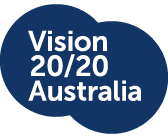First Nations peoples currently experience blindness and vision loss at three times the rates of other Australians.
People who are blind or have low vision are at higher risk of a range of adverse social and health outcomes, including increased risk of injury and depression. And, as the Commission’s issues paper acknowledges, both First Nations peoples and people with disability are at greater risk of experiencing harm than the general population.
The Commission asked “how can current systems better prevent or respond to experiences of violence, abuse, neglect and exploitation of First Nations people with disability?”. Vision 2020 Australia and its members believe the first step toward protecting First Nations peoples who are blind or have low vision from these outcomes is facilitating their independence wherever possible.
Vision 2020 Australia believes the NDIS has the potential to be a powerful mechanism for capacity-building for Australians living with blindness and low vision. However, current settings and arrangements mean that affected Australians are not always able to access the scheme as intended, or utilise their services to the fullest extent. This is especially true for First Nations peoples.
In considering the issues raised by the Commission, in this submission members of Vision 2020 Australia have noted some specific challenges experienced by First Nations peoples, as well as ways to address other problems observed with the interactions between the disability and health sectors in relation to First Nations peoples with disability.
The full submission can be viewed below in PDF and Word:
First Nations Peoples with disability – blindness and low vision perspectives PDF
First Nations Peoples with disability – blindness and low vision perspectives WORD
